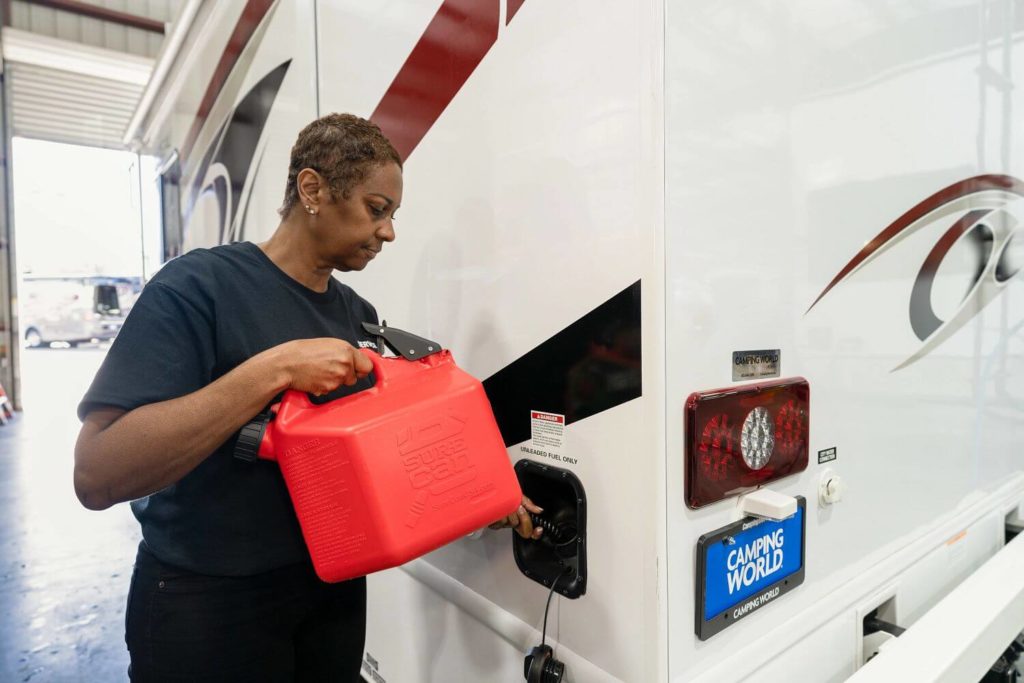Taking care of your motorhome, whether it’s a new or used motorhome, starts with the chassis and engine. Without the proper engine maintenance, you aren’t going anywhere – even if the rest of your RV is immaculate.
It might be easy to overlook, but your motorhome’s fuel filter plays an important role in keeping your RV on the road and the engine running efficiently. Let’s take a look at the fuel filter and some things you should know about it.
What Purpose Does a Motorhome Fuel Filter Serve?

Photo by Camping World
Your motorhome’s fuel filter catches dirt or debris before it can enter the fuel system. Some contaminants will simply reduce your fuel economy, while others can permanently damage your engine.
Your engine’s injectors are built to very tiny tolerances. This means that even the littlest bit of dirt or grime can clog them. The fuel filter keeps those injectors clean, allowing them to do their job and keep your engine running strong.
As you can imagine, fuel filters don’t last forever. Over time, they collect all the contaminants they keep out of your fuel system. If you don’t replace your fuel filter regularly, it becomes clogged, and contaminants may begin to bypass the filter and enter your fuel system.
That’s why changing your fuel filter according to the manufacturer’s recommendation is important.
Here are the main parts of a motorhome fuel filter:
- The Base Plate is where the filter meets your motorhome’s mounting assembly. It prevents leaks, maintains pressure, and allows for easy installation.
- The End Cap supports and holds the filter media. It attaches to the media using an adhesive and also prevents leaks.
- The Center Tube is usually made of steel and supports filtration, preventing it from collapsing inward while acting as an outlet for filtered fuel.
- The Filter Media is usually a cellulose or synthetic material that captures particulates and is typically pleated for more filtration surface area.
- The Compression Spring provides the force that holds the internal components in place throughout differential pressures.
- The Drain Valve, when present, allows fuel to bypass the filter media when the filtration media is too clogged to allow fuel to pass through.
- The Water Sensor on diesel fuel filters sends a signal to the RV’s dashboard when the water in the filter reaches a critical threshold. This signal tells the driver it’s time to drain water from the filter.
- The Canister is the housing that protects all the internal components. It’s usually made from steel and is designed to contain the pressure inside and prevent the filter from bursting.
Do All Motorhomes Have a Fuel Filter?

Photo by Camping World
You’ll find fuel filters on gas and diesel motorhomes, but they work slightly differently. Gasoline fuel filters generally have a single filtration medium that removes dirt and debris.
Diesel fuel typically includes more impurities than regular gasoline. So diesel fuel filters usually include two filtration mediums: one to remove larger debris and water, the other to remove finer particles.
The major difference is that diesel fuel filters remove water, and gasoline fuel filters do not.
How Often Do You Need a Motorhome Fuel Filter Replacement?
 Photo Camping World
Photo Camping World
You should change your fuel filter regularly, according to the manufacturer’s recommendation. Most manufacturers recommend replacing your fuel filter every 20,000 to 40,000 miles or at least every two years.
Changing it more frequently won’t hurt, but you shouldn’t neglect regular fuel filter replacement. If you do, you’re asking for an issue with your motorhome’s engine.
Every manufacturer will have slightly different advice on their recommended fuel filter replacement intervals. Consult your motorhome manufacturer’s guidelines.
If your RV sits idle in storage for long periods, you might also want to change the fuel filter because it’ll be full of fuel most of the time. As your vehicle sits idle, the fuel in that filter ages and can cause issues when you restart your engine.
If your motorhome sits for many months or even a year, you should probably consider changing the fuel filter before starting the engine.
Here are some signs you may have a dirty fuel filter:
- The engine won’t start or takes longer to start than normal.
- Your engine stalls, especially on hilly terrain.
- You’re experiencing better performance at high speeds than at low speeds.
- You feel engine hesitation when climbing or accelerating.
How to Change the Fuel Filter on a Diesel Motorhome
 Photo by Camping World
Photo by Camping World
Before changing your motorhome’s fuel filter on your own, recognize that the fuel system is under pressure. This pressure must be relieved before you remove the filter. This can typically be done by removing the gas cap, but it may require more extensive procedures on some RVs.
Most fuel filters also have three hoses connected to the top. These are usually one-way hoses, meaning that if you hook them up to the new fuel filter backward, you can cause significant damage to the new filter and your fuel system.
For these reasons, along with the delicate nature of the water sensor connected to the bottom of most motorhome fuel filters, we highly recommend contacting your local Camping World Service Center to schedule an appointment when it’s time to replace your RV’s fuel filter.
Fuel Additives Can Help



If your RV sits for more than two weeks at a time, you need to add some kind of fuel stabilizer to the fuel system. Make sure it’s a fuel stabilizer that’s designed to work with your engine.
Most fuel stabilizers are designed to work well in almost any engine, but you still need to do your due diligence to ensure you’re putting the right fuel additive in your tank.
Fuel additives are designed to keep gas fresh and help keep your engine inside clean. Most will protect for up to 24 months, meaning they’ll work great for winterizing your RV.
Explore Camping World’s full selection of fuel additives.
Don’t Forget Your Motorhome’s Generator
 Photo by Camping World
Photo by Camping World
Remember, there’s a fuel filter on almost all types of engines. Some are more robust than others. Your RV’s onboard generator or the portable generator you use while camping probably has one too.
When you change the fuel filter on your motorhome, think about changing the filter on your generator too. The same goes for fuel additives and stabilizers. Your generator will benefit from adding a stabilizer whenever it goes more than two weeks without use.
Here are more resources to help you use and maintain your generator:
- How to Winterize your RV Generator
- How to Maintain a Generator
- How to Change the Oil and Air Filter on Honda Portable Generators
Your motorhome’s fuel filter plays a vital role in the engine working at optimum efficiency. Replacing it regularly will keep you rolling down the road smoothly to your next camping destination.
Have a question about your fuel filter? Need help with RV maintenance? Comment below or give the Camping World Service Department a call today!
The post What Does A Motorhome Fuel Filter Do? appeared first on Camping World Blog.
By: Tucker Ballister
Title: What Does A Motorhome Fuel Filter Do?
Sourced From: blog.campingworld.com/learn-to-rv/what-does-my-motorhomes-fuel-filter-do/
Published Date: Thu, 20 Apr 2023 09:00:00 +0000
---------------------------------------------
 CampingSurvivalistHuntingFishingExploringHikingPrivacy PolicyTerms And Conditions
CampingSurvivalistHuntingFishingExploringHikingPrivacy PolicyTerms And Conditions
